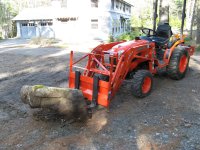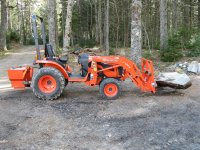newdeal - I've had a JD4300 with FEL for 10 years. From experience I can tell you that safety should be upper most in your mind when using a FEL. They are VERY dangerous if the recommendations in your owners manual aren't followed. Especially the rear weight recommendations.
Experience 1: As a newbie who was ignorant re the danger, I drove down the backside of my pond dam with an empty FEL, the rear had no ballast or anything else, and the tractor was in 2WD. It was in the morning with dew on the grass. I was about 1/2 way down the dam when all of a sudden the tractor just took off. Idiot me had no idea what was happening. I thought maybe the axis or something had broken. I slammed on the brakes but instead of stopping the tractor it just started to swerve side to side as it gained speed. By the time I reached the bottom of the dam the tractor was doing it's own thing and I was just along for the ride trying to steer it straight. Fortunately at the bottom of the dam was an open level field in which I was finally able to stop. The tractor came very close to rolling over.
Experience 2: A few years later I thought I had the FEL mastered. I was dumping some stones on the inside of the pond dam as erosion control. I had added wheel weights and a ballast box with 4WD engaged. Everything was going fine when (with a full load of stone in the FEL) one of the tractor's front wheels went slightly over the level dam top onto the steep inner dam. Three seconds and several OH S**Ts later the tractor was in the pond! The weight of the loaded FEL plus gravity leverage was enough to pull the tractor down the inside of the dam. Lucky for me that the tractor got stuck in the mud before it was completely submerged or I wouldn't be writing this reply today. Had to call a wrecker to pull the tractor out of the pond.
Lessons learned: Before using a FEL follow the rear weight recommendations in the owners manual, always engage 4WD (using a FEL on a 2WD tractor = RIP), use extreme caution around steep terrain, keep the bucket as low as possible and be ready to ground it if tractor stability is lost, increase PSI in front wheels to prevent blowouts, use a ROPS and a seatbelt. Remember, when something goes wrong it will probably happen so fast you will not have time to think logically or react properly. That's why it's so very important to stay alert and anticipate what might happen before using a FEL in various situations.

